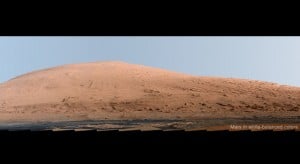
 Rising above the present location of NASA’s Mars rover Curiosity, higher than any mountain in the 48 contiguous states of the United States, Mount Sharp is featured in new imagery from the rover.
Rising above the present location of NASA’s Mars rover Curiosity, higher than any mountain in the 48 contiguous states of the United States, Mount Sharp is featured in new imagery from the rover.
A pair of mosaics assembled from dozens of telephoto images shows Mount Sharp in dramatic detail. This layered mound, also called Aeolis Mons, in the center of Gale Crater rises more than 3 miles above the crater-floor location of Curiosity. Lower slopes of Mount Sharp remain a destination for the mission, though the rover will first spend many more weeks around a location called “Yellowknife Bay,” where it has found evidence of a past environment favorable for microbial life.
Using infrared-imaging capability of a camera on the rover and an instrument that shoots neutrons into the ground to probe for hydrogen, researchers have found more hydration of minerals near the clay-bearing rock here than at locations Curiosity visited earlier.
The rover’s Mast Camera (Mastcam) can also serve as a mineral-detecting and hydration-detecting tool, reported Jim Bell of Arizona State University, Tempe. “Some iron-bearing rocks and minerals can be detected and mapped using the Mastcam’s near-infrared filters.”
Ratios of brightness in different Mastcam near-infrared wavelengths can indicate the presence of some hydrated minerals. The technique was used to check rocks in the Yellowknife Bay area where Curiosity’s drill last month collected the first powder from the interior of a rock on Mars.
“With Mastcam, we see elevated hydration signals in the narrow veins that cut many of the rocks in this area,” said Melissa Rice of the California Institute of Technology, Pasadena. “These bright veins contain hydrated minerals that are different from the clay minerals in the surrounding rock matrix.”
The Russian-made Dynamic Albedo of Neutrons (DAN) instrument on Curiosity detects hydrogen beneath the rover. At the rover’s very dry study area on Mars, the detected hydrogen is mainly in water molecules bound into minerals. “We definitely see signal variation along the traverse from the landing point to Yellowknife Bay,” said DAN Deputy Principal Investigator Maxim Litvak of the Space Research Institute, Moscow. “More water is detected at Yellowknife Bay than earlier on the route. Even within Yellowknife Bay, we see significant variation.”
Findings from the Canadian-made Alpha Particle X-ray Spectrometer (APXS) on Curiosity’s arm indicate that the wet environmental processes that produced clay at Yellowknife Bay did so without much change in the overall mix of chemical elements present. The elemental composition of the outcrop Curiosity drilled into matches the composition of basalt. For example, it has basalt-like proportions of silicon, aluminum, magnesium and iron. Basalt is the most common rock type on Mars. It is igneous, but it is also thought to be the parent material for sedimentary rocks Curiosity has examined.
“The elemental composition of rocks in Yellowknife Bay wasn’t changed much by mineral alteration,” said Curiosity science team member Mariek Schmidt of Brock University, Saint Catharines, Ontario, Canada.
A dust coating on rocks had made the composition detected by APXS not quite a match for basalt until Curiosity used a brush to sweep the dust away. After that, APXS saw less sulfur.
“By removing the dust, we’ve got a better reading that pushes the classification toward basaltic composition,” Schmidt said. The sedimentary rocks at Yellowknife Bay likely formed when original basaltic rocks were broken into fragments, transported, re-deposited as sedimentary particles, and altered by exposure to water.


Thanks for this column. I love this stuff. Getting that rover safely onto Mars was an amazing feat. I’m so glad it’s working so well on the ground there.